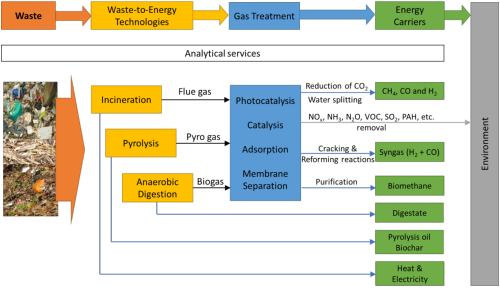ENREGAT offers services and access to the core facilities and equipment enabling research in the following areas:
Waste incineration
-
combustion tests - incineration of waste, fuels and refuse derived fuels,
-
evaluation of environmental impacts of combustion processes,
-
evaluation of energy efficiency of combustion processes and proposal of measures for its increase,
-
evaluation of produced emissions from combustion processes, proposal of measures reducing emissions production,
-
determination of physical and chemical parameters of waste and fuels,
-
material utilization of slag and fly ash from combustion processes.
Optimization of energy and materials waste recovery by thermochemical processes
-
pyrolysis and catalytic pyrolysis of waste (polymers, biomass, and other solid organic hazardous waste) in laboratory batch or semi-batch reactor, microwave reactor or continuous screw reactor; consulting on the scale up of the process,
-
catalytic cracking and reforming of hydrocarbons with the purpose of syngas refinement,
-
research of the possibilities of pyrolysis products (gaseous, liquid and solid) utilization.
Anaerobic digestion
-
conversion of biowaste (e.g. agricultural and food biowaste, organic fraction of municipal solid waste) to biogas and digestate by dry or wetdigestion in (semi) continuous regime,
-
use of applied microbiology to perform the pre-treatment of raw material for lignocellulose degradation,
-
physical modelling, process controlling and scale up.
Technologies for gas treatment
-
reduction of greenhouse gases (N2O) emission by catalysis and photocatalysis,
-
photocatalytic reduction of CO2 to useful products (CH4, methanol),
-
hydrogen generation by photocatalytic water splitting,
-
abatement of other pollutants (NOx, VOCs, NH3, CO, SO2, PAH, etc.) by catalysis, photocatalysis and adsorption,
-
material design - tailored preparation and modification of the materials in desired forms (grains, thin films, monoliths, foams) by conventional and unconventional methods for catalysis, photocatalysis and adsorption,
-
catalytic cracking and reforming of hydrocarbons with the purpose of the syngas and hydrogen production,
-
mutual correlation of the physico-chemical properties of materials and their efficiency for pollutant removal, stability and selectivity,
-
physical and mathematical modelling from micro- to macro scale, i.e. structure, mechanisms and kinetics, transport phenomena, equipment.

